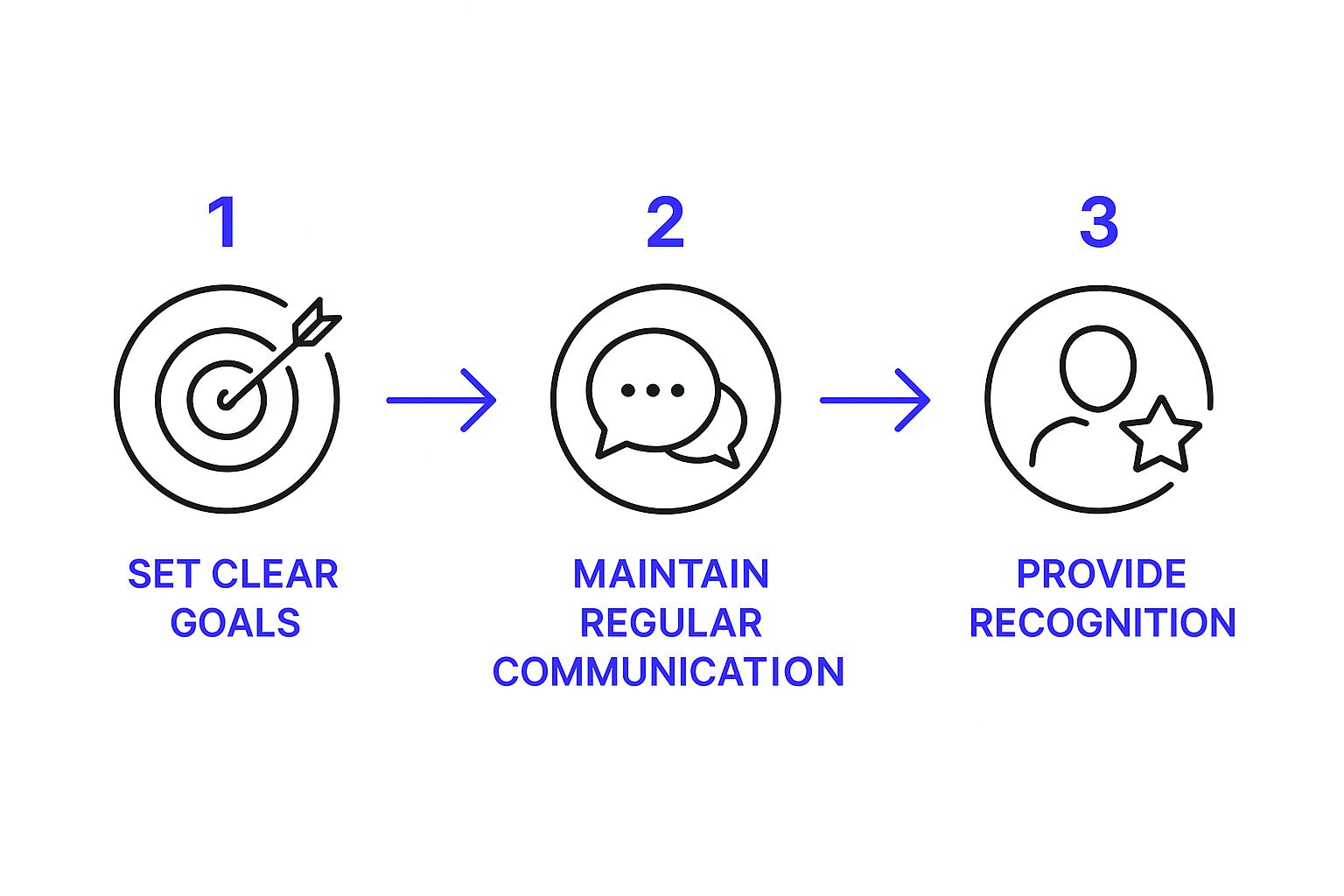Unlocking Remote Team Potential
Motivating remote employees centers on three essential pillars: building unshakable trust, fostering genuine connections, and celebrating contributions out in the open. When leaders measure success by outcomes instead of hours logged, and recognize wins in a personal way, engagement naturally follows.
As hybrid and fully remote teams become the norm, guiding dispersed talent isn’t optional—it’s a core leadership skill. By 2023, about 28% of employees worldwide worked from home, up from 20% in 2020. Even more striking, 91% of professionals say they prefer remote options and would switch jobs to keep that flexibility. Adapting your approach is key to keeping top performers on board. For a deep dive into actionable strategies for motivating remote employees, check out this comprehensive guide.
Building Trust, Connection, and Recognition
Trust, belonging, and public praise aren’t fancy perks—they’re the framework for motivated teams. Here’s how they play out in practice:
- Transparent Goals: Share objectives and progress in real time.
- Regular Check-Ins: Swap status emails for quick video huddles or voice notes.
- Spotlight Moments: Highlight wins in a team newsletter or dedicated Slack channel.
These simple rituals create a ripple effect: people feel invested, collaboration improves, and momentum grows.
Bridging Psychological Distance
It’s easy to think the main obstacle is geography. Really, it’s the gap in everyday human connection. Without casual chats by the coffee machine, teammates can drift apart from both each other and the company’s mission.
“When you shift from supervising activity to empowering people, you unlock autonomy—the single most powerful motivator for remote teams.”

This visual captures a straightforward cycle: clear goals set the direction, consistent communication keeps everyone aligned, and immediate recognition reinforces positive habits.
Core Strategies for Remote Motivation
Below is a quick reference table outlining each tactic, where it makes the biggest impact, and a concrete first step you can take today.
| Strategy | Focus Area | Example Action |
|---|---|---|
| Transparent Communication | Trust Building | Host weekly one-on-ones with clear, shared agendas |
| Team Rituals | Connection | Kick off Mondays with a 15-minute virtual coffee break |
| Public Recognition | Engagement | Spotlight achievements in a dedicated Slack channel |
| Outcome-Based Goals | Autonomy | Define deliverables instead of logging daily hours |
| Personal Check-Ins | Support | Send personalized messages when milestones are reached |
Use this snapshot to pick a tactic that suits your team’s current needs.
Rethinking Traditional Motivators
Many office-based perks lose their impact when everyone’s dialing in from home. Instead, gear your efforts toward motivators that resonate remotely:
- Clarity and Purpose: Help each person see how their work fuels broader company goals.
- Flexibility and Autonomy: Trust your team to structure their own day.
- Support and Connection: Foster a sense of community to combat isolation and burnout.
By leaning into these intrinsic drivers, you’ll build a resilient, high-performing team that thrives no matter where they’re located. For more insights into evolving remote preferences, explore the latest data on remote work preferences on Splashtop.com.
Give Your Team Trust and Autonomy
When you're managing a remote team, trust isn't just a nice-to-have—it's everything. It forms the very foundation of a motivated and high-performing workforce.
The biggest shift you can make is moving away from tracking hours to focusing on results. As soon as you give your team ownership over their outcomes, you'll see them take more pride and accountability in their work. All they need are clear goals and realistic deadlines to guide them.
A few practical ways to do this:
- Clearly define what needs to be done, who owns it, and when it’s due.
- Be transparent about how you measure success. Share your decision-making criteria so everyone is on the same page.
- Let your team schedule their own workdays. Encourage them to work when they feel most productive, not just from 9 to 5.
This isn't about letting go of the reins completely; it's about trading micromanagement for genuine confidence in your team's abilities.
Focus on Tracking Outcomes, Not Hours
Instead of having everyone fill out timesheets, start measuring success by the milestones they achieve. This is where tools like Bulby can make a real difference, helping your team map out projects, identify potential roadblocks, and clarify who’s responsible for what.

I saw this work firsthand when a marketing lead gave her writers a monthly content budget and some basic guidelines, then let them manage their own sprint schedules. The result? Productivity jumped by 20%, and morale soared because the writers finally felt in control of their own workflow.
When employees feel trusted to manage their own schedules, they don't just do the bare minimum—they invest their best effort.
As a leader, your role shifts to running regular check-ins that are focused on removing obstacles, not checking up on what time someone logged in.
Empower Your Team with Shared Frameworks
In the real world, remote teams thrive when they understand the "why" behind decisions. You can empower them by providing simple, transparent frameworks, like a decision matrix or a scoring rubric, so everyone knows what a win looks like.
Here’s a quick case study:
- A product team started using a public Kanban board where features were rated based on customer impact.
- Team members could move tasks through the workflow themselves, without needing a manager's sign-off at every stage.
- Their release speed doubled, and the level of trust across different functions grew almost overnight.
It turns out, cooperation and trust are far more powerful motivators than simply being in the same office. A Great Place to Work® analysis of 1.3 million employees found that when colleagues can count on each other, they are 8.2 times more likely to go the extra mile.
Thinking long-term, investing in effective staff training for impact and retention is also key, as it builds both skills and self-reliance.
When you stop monitoring presence and start empowering people, you’re not just managing a team—you’re building a results-driven culture.
Make Goals and Progress Visible
One of the biggest fears for remote workers is being "out of sight, out of mind." You can eliminate that anxiety by making team priorities public in a shared workspace like Bulby. This way, everyone can see goals and any shifts in real-time.
Trust blossoms when each person can update their progress asynchronously. This simple habit dramatically reduces the need for all those draining status update meetings. In fact, teams I've worked with have reported cutting their weekly meeting time by 30% just by using open roadmaps in Bulby.
To take it a step further, get your team involved in defining risk thresholds and escalation paths. This clarifies boundaries and reinforces the idea that success criteria are created together, not just handed down from on high.
Ultimately, motivating a remote team comes down to letting them own their work from start to finish. When you combine clear frameworks with real autonomy, you create an environment where motivation isn't something you have to force—it just happens naturally.
Fostering Meaningful Virtual Connections
When your team is remote, the small things we used to take for granted—like grabbing coffee or just chatting in the hallway—disappear. Those spontaneous moments are the glue that holds a team together, and without them, people can start to feel isolated, lonely, and disconnected from the company's mission. Zoom fatigue is real, and it can quickly drain your team's morale.
This is where you, as a leader, have to be intentional. It's not about forcing fun; it's about creating spaces where genuine connections can happen naturally. You need to carve out time for casual, non-work conversations that go beyond the standard meeting agenda.

Create Dedicated Social Spaces
To push back against that feeling of isolation, you can create specific channels or regular events designed purely for social interaction. These informal touchpoints build empathy and strengthen the personal bonds that fuel great collaboration.
Here are a few simple ideas that work:
- Topic-Based Channels: In Slack or Teams, try setting up channels for shared interests. Think #pet-photos, #book-club, or #weekend-wins. It’s a low-pressure way for people to connect over things they love.
- Virtual Coffee Breaks: Put optional 15-minute coffee chats on the calendar. The only rule? No work talk allowed.
- Show-and-Tell Sessions: A tech startup I once worked with had rotating hosts lead quick show-and-tell sessions. Team members would share a hobby, a recent book they read, or something cool they found.
These activities don't take a lot of effort, but they go a long way in building a sense of community. They help teammates see each other as real people, not just names on a screen. If you're looking for more inspiration, check out these https://www.remotesparks.com/virtual-team-engagement-ideas-2/ to find what might click with your team's culture.
The most powerful connections are often built during unstructured moments. By creating opportunities for casual interaction, you give your team the space to build genuine rapport that translates directly into better teamwork.
Embrace Asynchronous Connection
But here’s the thing: meaningful connection doesn't always have to happen live. In fact, overloading calendars with even more meetings can completely backfire and lead to more burnout. The trick is to use asynchronous methods to build rapport without adding yet another meeting to the schedule.
You can bridge communication gaps and share updates without a meeting by using tools like asynchronous video messages like Loom videos. A short video shout-out celebrating a team win or a quick "hello" message can feel incredibly personal and motivating.
This approach respects everyone's time while still making team members feel seen and valued. The goal is to weave connection into the fabric of your remote culture so it becomes a natural part of the workday, not just another task on the to-do list.
Recognizing Remote Employee Achievements
When your team is spread out, it's easy for great work to go unnoticed. People can start to feel like their efforts are disappearing into a void. That's why building a culture of recognition isn't just a "nice-to-have"—it's one of the most powerful motivators you have. It bridges the physical distance and reinforces that their work truly matters.
The trick is to make praise a visible, frequent, and shared activity. Forget waiting for the annual review; small, consistent shout-outs often mean more than a once-a-year award. A great way to get started is by encouraging everyone on the team to recognize each other.
Making Recognition a Team Habit
To get recognition to stick, you have to weave it into your team's daily routine. The easiest way? Use the tools you're already in every day. Set up a dedicated channel in Slack or Microsoft Teams—name it something fun like #wins or #kudos. This becomes the go-to spot for anyone to publicly thank a colleague or celebrate a project milestone.
This simple setup does two brilliant things at once. First, the person getting the praise gets an instant morale boost. Second, it shows the rest of the team what great collaboration and success look like in practice.
A few ideas to get the ball rolling:
- Weekly Wins Segment: Carve out just five minutes in your weekly team sync for people to share a personal win or give a shout-out to someone who helped them.
- Virtual Badges: When a major project milestone is hit, celebrate it with a fun digital badge or a custom GIF in your main team channel.
- Leadership Participation: It’s crucial for managers and leaders to actively participate. When they consistently recognize people in public channels, it sends a clear message that appreciation is a core value.
These small rituals create a positive feedback loop, encouraging everyone to look for and celebrate the good work happening around them. To take that team spirit even further, you can check out some of the best remote team ice breakers to boost connection and engagement to help build genuine rapport.
When you make recognition a shared responsibility, it stops feeling like a top-down mandate and becomes an authentic part of your team's culture.
Personalizing Rewards for Maximum Impact
Public praise is fantastic, but personalized rewards show you’re paying attention on a whole other level. A generic gift card is fine, but a thoughtful gesture that connects with someone's actual interests shows you genuinely care.
I once worked with a marketing agency that kept a simple, private document of each team member's favorite things—their go-to coffee shop, hobbies, even their preferred food delivery app. It was nothing fancy, but it was incredibly effective.
When it was time to recognize someone for going above and beyond, they could pick something that would actually mean something to that person:
- A gift card to that local café they always talk about.
- A subscription box tailored to their hobby, like books or craft supplies.
- An extra day off, framed as a "wellness day" to unplug and recharge.
This completely changes the dynamic. Recognition becomes a meaningful connection, not just a transaction. It shows your team that you see them as people, not just names on a screen. By mixing consistent public praise with thoughtful, personalized rewards, you build a resilient and motivated team that feels seen, valued, and connected to your mission.
Champion Well-Being and Work-Life Balance
When your home office is also your living room, the line between "on" and "off" can get dangerously blurry. Suddenly, you're in a non-stop cycle of pings and tasks, and burnout becomes less of a risk and more of an inevitability. If you want to keep your remote team motivated for the long haul, you have to get serious about preventing this.
It all boils down to setting clear boundaries. That means defining core working hours when everyone should be available and establishing realistic expectations for response times. But the real magic happens when leaders walk the talk—logging off on time and taking their full vacation without peeking at emails. That sends a powerful message: we respect your personal time.
Encourage a Real Disconnect
Actively encouraging your team to unplug can make a huge difference in morale and productivity. I once worked with a customer support team that started sending out daily reminders for quick stretches and offered optional five-minute meditation breaks. The result? They saw a 30% drop in late-night messages and a 25% bump in their job satisfaction scores.
Here are a few simple ideas that really work:
- Offer Real Wellness Resources: Go beyond lip service. Provide access to an employee assistance program (EAP) or subscriptions to popular mindfulness apps like Calm or Headspace.
- Create "No-Meeting" Zones: Block out specific times, like Friday afternoons, to be meeting-free. This gives everyone a chance to do deep work or even get a head start on their weekend.
- Build in True Flexibility: Your policies should empower people to handle life—like a kid's school play or a doctor's appointment—without feeling like they're letting the team down.
Taking these steps shows you see your team as whole people, not just a collection of outputs. If you're looking for more inspiration, these remote team engagement ideas can help you keep everyone connected and energized.
The Clear Link Between Balance and Motivation
This isn't just about feeling good; it's a direct driver of motivation. Study after study confirms that remote work makes people happier and more satisfied, mainly because they get a better work-life balance and ditch the soul-crushing commute.
In fact, 74% of employees say they're happier working remotely. That flexibility is so valuable that half of them would even consider a pay cut to keep it. You can dig into more of this data in the full remote work statistics on Strongdm.com.
By championing work-life balance, you're not just preventing burnout; you're creating the very conditions that allow intrinsic motivation to flourish. A supported, rested employee is an engaged and productive one.
Ultimately, promoting a healthy work-life balance comes down to one thing: trust. It's about trusting your team to manage their time and energy, and giving them the permission and tools to put their well-being first. This is how you build a sustainable, positive culture where people feel respected, valued, and motivated to bring their A-game—no matter where their desk happens to be.
Using Tools to Enhance Remote Engagement

Let’s be honest: remote work can feel a bit disconnected at times. Without the right setup, that physical distance can easily turn into emotional distance. But the good news is, the right set of tools can transform that gap into a space for dynamic, focused teamwork.
When you're trying to figure out how to motivate your remote employees, the key is to build a simple, powerful tech stack. Think of it as creating a central hub for communication and pairing it with a clear, visual way to track work.
For instance, by centralizing conversations in a platform like Slack or Microsoft Teams, you create a single, searchable source of truth for every decision. Then, you can add a lightweight project tracker like Trello or Asana so everyone can see progress at a glance, without needing to ask for an update.
A solid remote toolkit usually includes:
- A Communication Hub with search and threads to keep async conversations organized.
- A Project Tracker with visual boards that bring total transparency to who’s doing what.
- Peer Recognition Apps to celebrate the small wins and boost team morale.
- Icebreaker Bots like Donut to spark those casual, "water-cooler" connections automatically.
These pieces form the backbone of your engagement strategy and help establish a natural rhythm for how your team works together.
Of course, just having the tools isn't enough. You have to actively manage and refine your tech stack based on how your team is actually using it. Start by auditing what you currently have, gather some honest feedback, and don't be afraid to make changes.
A simple monthly check-in can make a huge difference. Look at which channels are active, survey your team on what's easy to use and what isn't, and get rid of any features or integrations that are just adding friction. When you hit a big milestone, celebrate it in your tools to reinforce their value.
Choosing Your Core Communication Hub
The chat platform you choose will shape your team's daily habits more than almost anything else. I saw this firsthand with a finance firm I worked with. They started running quick pulse surveys in a shared channel, which helped them spot a dip in morale before it became a major issue.
Because they caught it early, managers were able to hold a few short, focused coaching sessions, and team satisfaction jumped by 15% in just two weeks. It all started with the right tool.
When you automate routine updates, you free up your team to focus on meaningful work instead of just reporting on it.
A good communication hub allows you to:
- Run Quick Pulse Surveys to capture team sentiment in seconds.
- Set up Automated Status Updates to eliminate manual reporting.
- Use Bot-Driven Icebreakers to build personal connections.
Automating Updates for Meaningful Work
Nothing drains motivation faster than tedious, repetitive check-ins. When your tools can handle the grunt work of status updates, your team gets to spend more of their brainpower solving real problems.
This is where integrations become so powerful. You can connect your project boards with a tool like Bulby to guide brainstorming sessions and capture action items without missing a beat. Adding asynchronous surveys alongside progress logs helps surface potential roadblocks early, when they're still easy to fix.
If you want to dig deeper into these practices, our guide on asynchronous communication best practices is a great place to start.
Encourage your team to find and experiment with add-ons that plug into your core hub. I remember one startup that paired their Trello cards with a simple shout-out app. The result? They cut their internal email volume by 30% while simultaneously boosting team engagement.
The goal is to continuously refine your tools to sustain momentum. Use the built-in analytics to see what’s working, make small adjustments, and always keep an eye on whether these tools are helping you achieve your desired outcomes.
Your Questions Answered: How to Motivate Remote Employees
Even with a solid plan, managing a remote team brings up unique questions. I've been there. Here are my answers to some of the most common hurdles I see leaders face when trying to keep their distributed teams fired up.
How Do You Measure Productivity Without Micromanaging?
This is a big one. The secret is to stop focusing on activity and start measuring outcomes. Micromanagement is usually rooted in fear—the fear that if you can't see people working, they aren't. But tracking online status or mouse clicks? That’s the fastest way to kill trust and send motivation plummeting.
Instead, define what success actually looks like for each role. Make it tangible.
- Does it mean hitting specific sales targets each quarter?
- Is it about shipping project milestones on time?
- Or maybe it's maintaining a certain customer satisfaction score.
Once you and your team agree on these key results, your weekly check-ins are no longer about "what did you do all day?" They become strategic conversations about progress, roadblocks, and how you can help. This gives your team the autonomy they crave and ensures everyone is accountable for what truly matters.
A manager's job isn't to watch people work; it's to clear the path so they can do their best work. Trust your team with the "how," and they'll almost always deliver better results.
What Tools Actually Help Keep Remote Teams Engaged?
You don't need a complicated tech stack to foster engagement. From my experience, the most effective setups combine three key elements: a central hub for communication, a clear system for managing projects, and a dedicated space for celebrating wins. It’s about creating an environment where teamwork and recognition just happen.
Think of it as your remote leadership toolkit:
- A Core Chat Platform: Something like Slack or Microsoft Teams is non-negotiable. It's where real-time conversations, async updates, and even social channels live.
- A Visual Workflow Tracker: You need a single source of truth for projects. Tools like Trello or Asana give everyone a shared view of who’s doing what and when it’s due. No more confusion.
- A Recognition App: Integrating a simple tool like Bonusly or HeyTaco! right into your chat platform makes peer-to-peer shout-outs effortless and public, which builds a culture of appreciation.
The goal here is to pick tools that make work easier, not add another layer of complexity. If you want to dig deeper, our guide on how to engage remote employees has even more specific ideas.
How Can I Onboard a New Remote Hire Effectively?
A great remote onboarding experience has to be both highly structured and deeply personal. That first week is your one shot to make a new hire feel welcomed, informed, and truly part of the team. You can't just send them a laptop and expect them to figure it out.
Map out their first five days in detail, making sure to balance need-to-know training with informal social time. One of the best things you can do is assign them an onboarding "buddy."
This isn’t a manager; it’s a peer whose job is to schedule a quick call each day to check in, answer the "silly" logistical questions, and invite the new person to virtual coffee chats or team socials. It provides a friendly, low-pressure point of contact and helps them build real connections from day one.
What Should I Do If a Remote Employee Seems Disengaged?
When you notice someone pulling back or going quiet, your first move should be a private, one-on-one conversation. And it needs to come from a place of empathy, not accusation. Disengagement is almost always a symptom of something bigger—burnout, unclear goals, or personal struggles.
Start the conversation with open-ended questions. Get their perspective.
You could ask things like, "How are you feeling about your current workload?" or "Do you feel like you have all the resources you need to succeed right now?"
Then, just listen. Really listen. Based on what they share, you can offer tailored support. That might mean shifting a few deadlines, scheduling more frequent check-ins for a while, or pairing them with a colleague for support on a tricky project. When you show you genuinely care about them as a person, you're doing more to motivate them than any perk ever could.
Ready to unlock your remote team's full creative potential? Bulby provides guided, research-backed brainstorming exercises that eliminate bias and ensure every voice is heard. Turn your virtual meetings into idea powerhouses at https://www.bulby.com.

